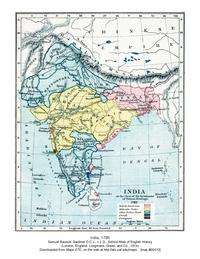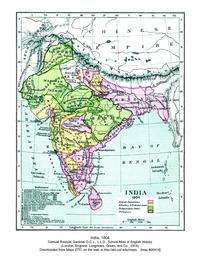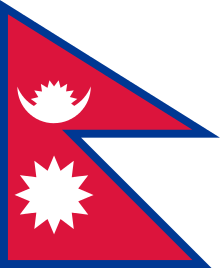Greater Nepal
Part of a series on the |
|---|
| History of Nepal |
 |
|
| Timeline |
|
|
Greater Nepal is a concept of Nepal extending beyond its present boundaries to include present day Indian territories controlled briefly by the Gurkha army after defeating some South Asian kingdoms in wars fought from 1791 to 1804 but ceded to the East India Company under the Sugauli Treaty (treaty for Partition of Nepal) after the Gurkha king was defeated in the 1814–16 Anglo-Nepalese War. In 1813, the historical Greater Nepal extended from the Sutlej to the Tista, spanning 1500 kilometres. Rule over this expanse was brief, however, and in the aftermath of the 1814-1815 war with the East India Company the Gorkhali realm was whittled down considerably. The real time Gorkhali presence in Garhwal was for over a decade; Kumaon for 25 years; and Sikkim for 33 years. The Treaty of Sugauli, between the Gorkhali king and the Company, was ratified in 1816. It caused Nepal to lose about 105,000 km2 of territory and left Nepal as she is today, with 147,181 km2 of present total area.
Campaigns by Shah kings

King Prithvi Narayan Shah (1723–75) of the Shah dynasty decided to enlarge the kingdom that was confined to the small Gorkha region of Nepal and had an area of just 2,500 square kilometres (970 sq mi). He defeated major principalities in wars and unified them under his rule starting from the 1740s ending with shifting of his Gorkha Kingdom’s capital from Gorkha region to Kathmandu in 1769. He then attacked and absorbed dozens of other small principalities of Nepal area to his Gorkha kingdom. After his death in 1775, his eldest son Pratap Singh Shah continued defeating other smaller princes and absorbing their fiefdoms. Pratap Shah died at the age of twenty-five in 1777. Then Prithvi Narayan Shah’s second son, Bahadur Shah, ruled until 1794.





Wars with kingdoms in neighbouring countries, British India and Tibet
Victory over Kumaon Kingdom, Garhwal Kingdom and Kangra
The Gorkha army invaded Kumaon Kingdom and occupied it in 1790–91. [1][2] Then the Gorkha army invaded Garhwal Kingdom and occupied it in 1804 after defeating its King Pradyuman Shah. The southern border of Nepal extended to Allahabad after absorption of Palpa Kingdom, including the Terai sector of Butwal taken by the king of Palpa from the king of Awadh on lease in 1801. In 1806, the Gorkha army absorbed all the small kingdoms like Sirmudh state, Hindur and Besahar lying across the Garhwal and up to Satluj River. In this way, the Gorkhas unified the hilly regions such as Nainital, Almora and Dehradun without crossing the Satluj River. However, when the Gorkhas crossed the Satluj river, the Gorkha's attack on Kangra and siege of Kangra Fort west of Satluj river was repulsed by the Kangra king with help from Maharaja Ranjit Singh of Punjab in 1809. Later the Gorkha army absorbed Kangra and extended the kingdom to Ravi river, India. This could not last long as Nepal signed Sugauli treaty.
Victory over Sikkim and Darjeeling
Previously Darjeeling formed a part of dominions of the Raja of Sikkim, who had been engaged in an unsuccessful warfare against the Gorkhas. From 1780 the Gorkhas continually made inroads into Sikkim. Sikkim lost most of its land to Nepal and by the beginning of the 19th century, the Gorkhas had overrun Sikkim as far-eastward as the Teesta and had conquered and annexed the Terai.[3]
Sugauli Treaty
The East India Company had come to rule much of north India by the time the Gurkhas attacked kingdoms in South Asia. The Company became the de facto ruler of South Asia east of Satluj river in place of the Moghuls, Marathas and other kings, especially after defeating the Marathas in 1803 in Second Anglo-Maratha War. After firmly establishing its rule over Delhi in 1803, the Company attacked the Gorkhas and repulsed them from Kumaon Kingdom and Garhwal Kingdom in the area west of Kali river and in Sikkim and north Bengal east of Teesta river by 1815. The Gorkhas were forced to accept a peace treaty with the British (the Sugauli Treaty) in 1816.
Present-day view
Pushpa Kamal Dahal, the chairperson of Maoist party, who spent 10 years of his life in India after being declared a terrorist by the Nepalese government, after becoming PM of Nepal said in an interview with Times of India in 2005 that Greater Nepal was a "media-created stunt".[4]
See also
 Nepal portal
Nepal portal- East India Company
- British Raj
- History of Nepal
- Kingdom of Nepal
- History of India
- History of Sikkim
- Politics of Nepal
- 1950 Indo-Nepal Treaty of Peace and Friendship
References
- ↑ "Kumaon and Garhwal Coin History - Uttarakhand Worldwide - Excerpts from the history of Uttaranchal Through Coins".
- ↑ "The Enclosing of Nepal". U.S. Library of Congress. countrystudies.us. Retrieved 30 November 2010.
- ↑ "History - Pre-Independence". darjeeling.gov.in. Retrieved 30 November 2010.
- ↑ "Nepal Maoists produce maps to claim parts of India". Times of India. 25 October 2005. Retrieved 13 December 2012.
External links
- Bellinfosys.com (important dates in the history of Garhwal.)
- Bordernepal.com
- The Gurkhas origin exploration and expansion